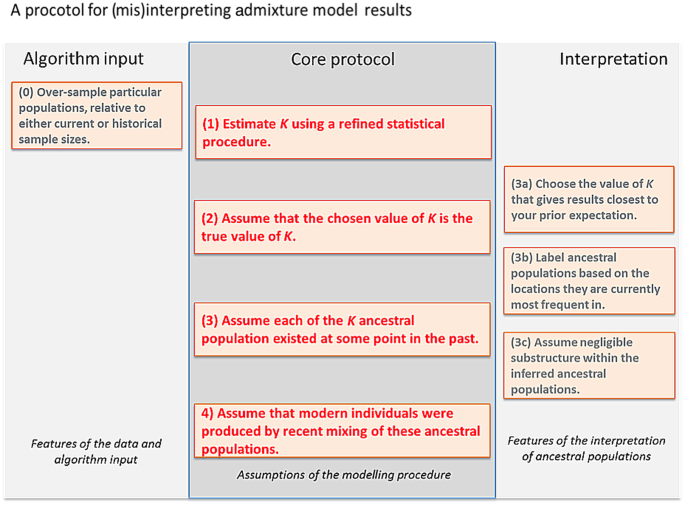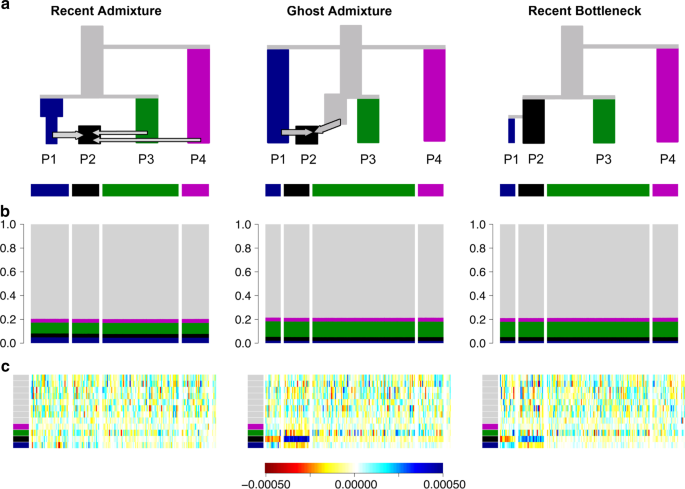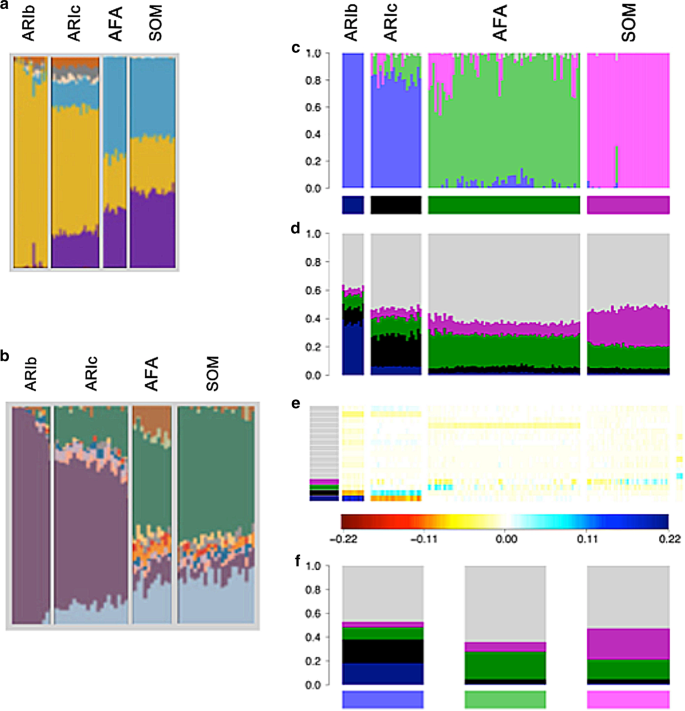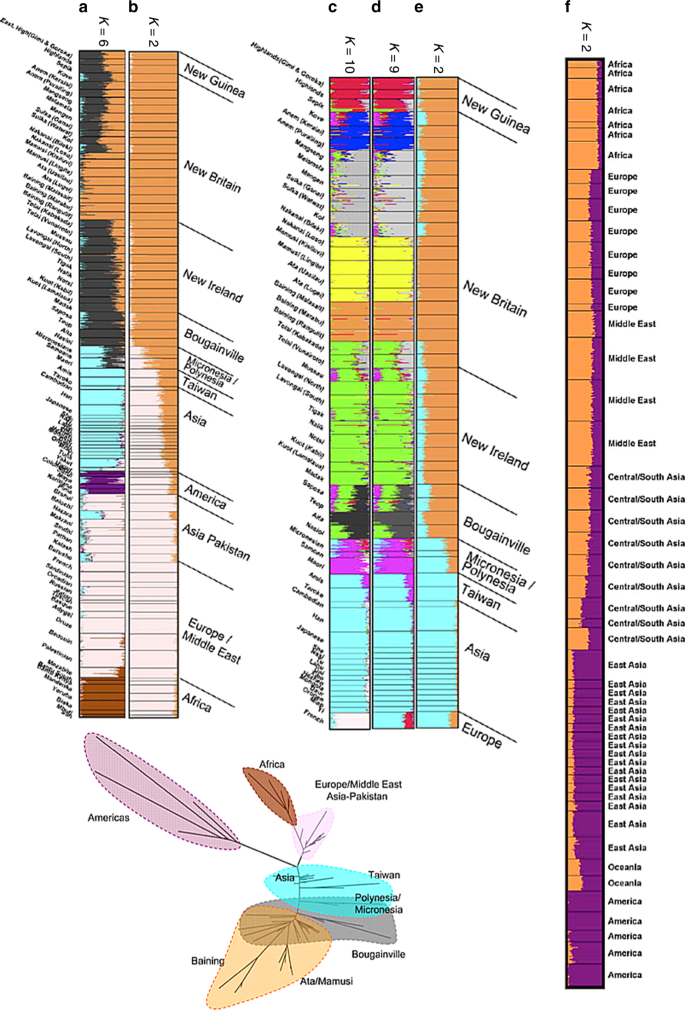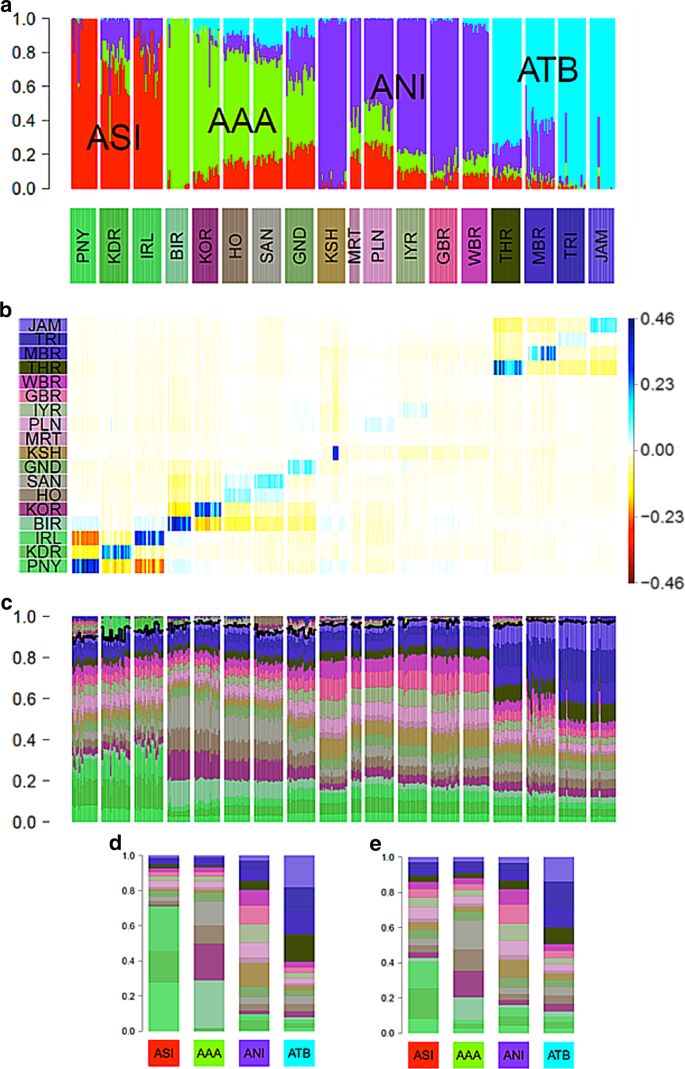A tutorial on how not to over-interpret STRUCTURE and ADMIXTURE bar plots (original) (raw)
The default interpretation protocol
Most researchers are cautious but literal in their interpretation of STRUCTURE and ADMIXTURE results, as caricatured in Fig. 1, as it is difficult to interpret the results at all without making several of these assumptions. Here we use simulated and real data to illustrate how following this protocol can lead to inference of false histories, and how badMIXTURE can be used to examine model fit and avoid common pitfalls.
Fig. 1
A protocol for interpreting admixture estimates, based on the assumption that the model underlying the inference is correct. If these assumptions are not validated, there is substantial danger of over-interpretation. The “Core protocol” describes the assumptions that are made by the admixture model itself (Protocol 1, 3, 4), and inference for estimating K (Protocol 2). The “Algorithm input” protocol describes choices that can further bias results, while the “Interpretation” protocol describes assumptions that can be made in interpreting the output that are not directly supported by model inference
Case study 1: African Americans
In order to understand the assumptions underlying the STRUCTURE model, it is helpful to think about an example that was originally used to motivate it, namely the ancestry and genetic history of African Americans. The “admixture model” of STRUCTURE assumes that each individual has ancestry from one or more of K genetically distinct sources. In the case of African Americans, the most important sources are West Africans, who were brought to the Americas as slaves, and European settlers. The two groups are thought to have been previously separated with minimal genetic contact for tens of thousands of years. This means that their history can be separated into two phases, a “divergence phase” lasting thousands of years of largely independent evolution and an “admixture phase”, in which large populations met and admixed within the last few hundred years. Specifically, most of the ancestors of African Americans that lived 500 years ago were either Africans or Europeans. The goal of the algorithm is to reconstruct the gene frequencies of these two distinct “ancestral” populations and to estimate what proportion of their genome each African American inherited from them.
When the STRUCTURE admixture model is applied to a data set consisting of genetic markers from West Africans, African Americans and Europeans it infers two ancestral populations1. Each of the Europeans and Africans are assigned a great majority of their ancestry from one of them. African–Americans are inferred to have an average of 18% ancestry from the European cluster but with substantial inter-individual variation14.
Assignment of clusters in this case is readily biologically interpretable. There are of course genetic differences amongst both the Africans and the Europeans who contributed to African–American ancestry, e.g., reflecting genetic variation between regions within Europe and Africa, but the divergence between Europeans and Africans took place over millennia and is of a different magnitude. These subtle differences are likely to have a relatively minor effect on the amount of African and European ancestry estimated for each individual. Therefore the STRUCTURE admixture proportion is a reasonably accurate estimate of the recent admixture fraction.
Different scenarios give indistinguishable ADMIXTURE plots
Many real population histories are not neatly separable into divergence and admixture phases but the methods can be applied to any data set, producing ancestry bar plots. Figure 2 shows admixture histories inferred by ADMIXTURE for three demographic scenarios. These simulations were performed with 13 populations (see “Methods” section)—which provides valuable out-group information—but only results for the four most relevant populations are shown. The “Recent Admixture” scenario represents a history qualitatively similar to African Americans, in which the admixture model holds. The true history is that P2 is an admixture of P1, P3 and P4. ADMIXTURE, interpreted according to the protocol, infers that this is what happened and estimates approximately correct admixture proportions (true admixture proportions are 35% light green and 15% light pink).
Fig. 2
Three scenarios that give indistinguishable ADMIXTURE results. a Simplified schematic of each simulation scenario. b Inferred ADMIXTURE plots at K = 11. c CHROMOPAINTER inferred painting palettes. d Painting residuals after fitting optimal ancestral palettes using badMIXTURE, on the residual scale shown. e Ancestral palettes estimated by badMIXTURE. 13 populations in total were simulated, with grey populations all being outgroups to those shown in colour
In the “Ghost Admixture” scenario, P2 is instead formed by a 50–50% admixture between P1 and an unsampled “ghost” population, which is most closely related to P3. In the “Recent Bottleneck” scenario, P1 is a sister population to P2 that underwent a strong recent bottleneck. The ADMIXTURE plots are almost identical between the three scenarios. Since the “Ghost Admixture” and “Recent Bottleneck” scenarios cannot be represented using a simple admixture description, the model cannot be historically correct. Nevertheless, the algorithm attempts to fit the data as best it can by finding the combination of admixture proportions and ancestral frequencies that best explain the observed patterns.
To be specific, in the Ghost Admixture scenario of Fig. 2, the ghost population is modelled as a mix of the sampled populations it is most closely related to, rather than being given its own ancestral population. For this scenario, the larger proportion of ancestry inferred from the light green population rather than the light pink one does not reflect a difference in admixture proportions, since neither P3 nor P4 actually contributed genetic material to P2. Rather, it reflects the fact that P3 is more closely related to the unsampled ghost population, as seen in the phylogeny.
In the Recent Bottleneck scenario, ADMIXTURE models the genetic drift shared by P1 and P2 by assigning both populations some ancestry from the light blue ancestral population. The strong recent drift specific to P1 is approximately modelled by assigning more light blue ancestry to P1 than to P2, thereby making P1 more distinct from the other populations in the sample. The remaining ancestries assigned to P2 are from the most closely related of the remaining ancestry components, again in proportions that reflect phylogenetic distance rather than admixture fractions. An alternative outcome in both scenarios would be for ADMIXTURE to infer a higher value of K and to include an extra ancestral population for P2. The algorithm is more likely to infer this solution if there was stronger genetic drift specific to P2 or if members of the population made up a greater overall proportion of the sample.
badMIXTURE results distinguish between scenarios
badMIXTURE uses patterns of DNA sharing to assess the goodness of fit of a recent admixture model to the underlying the genetic data. These sharing profiles are generated using CHROMOPAINTER11, which calculates, for each individual, which of the other individual(s) in the sample are most closely related for each stretch of genome, using either haplotype or allele matching. This process is called “chromosome painting”, and can be thought of in terms of “palettes” (Fig. 2c), which can also be visualised as bar plots. The palette measures the proportion of the genome of each individual that is most closely related to the individuals sampled from each of the labelled populations. The painting palettes differ for the three simulated scenarios (Fig. 2c), showing that there should be information in the genetic data to distinguish between them, even though they give almost identical ADMIXTURE bar plots.
STRUCTURE and ADMIXTURE estimate both the ancestral gene frequencies and the admixture proportions for each individual in the sample. badMIXTURE assumes that the admixture proportions estimated by STRUCTURE and ADMIXURE are correct and uses matrix factorisation to find the combination of ancestral palettes that give the best overall fit (evaluated using least squares) to the palettes of each individual. Crucially, under a number of reasonable assumptions (see Methods), in a recent admixture scenario, the palettes of admixed individuals should be a mixture of the palettes of non-admixed individuals according to the relevant admixture proportions.
In other words, if a simple admixture scenario is correct and the proportions are correctly estimated by STRUCTURE/ADMIXTURE, then it should be possible to use the N_×_K admixture proportions of the N individuals in the sample and the K × P palettes proportions for the K ancestral populations to predict the N × P palette proportions for each individual. The fit of the model can be examined by comparing the true palette proportions for each individuals to the ones predicted by badMIXTURE. An admixture model can only be a parsimonious way of describing the data if there are more distinct ancestry profiles than there are ancestral populations, since otherwise each ancestry profile could simply be assigned its own ancestral population. Therefore, badMIXTURE assumes there are more distinct ancestry profiles P than there are populations K.
Figure 2d shows the residuals, representing the difference between the observed palettes for each individual in the simulated data and those reconstructed by badMIXTURE. Figure 2e shows the corresponding palettes inferred for each ancestral population. Under the Recent Admixture scenario, there is no systematic pattern to the residuals. For the Ghost Admixture scenario, the residuals show a systematic pattern, with the model substantially underestimating the proportion of palette that individuals in P2 have from their own population and overestimating the contributions from the other populations. For the Recent Bottleneck model, the deviations are similar—the main qualitative difference between the Ghost Admixture scenario and Recent Bottleneck scenario are in the ancestral palettes. Ghost Admixture produces a more uniform ancestral palette than either of the other models, which both contain bottlenecks for P1.
badMIXTURE distinguishes the Recent Admixture scenario from alternatives because the Recent Admixture model makes the distinct prediction that admixed individuals are not particularly related to each other, as shown by the small amount of black in their palettes in Fig. 2c. Members of P2 get 50% of their genomes from the light blue ancestral population, 35% from the light green population and 15% from the light pink one, while P1 received all of its ancestry from the light blue population. For any given locus, a member of P2 will have the same ancestral source as a member of P1 50% of the time. However, two members of P2 will have the same ancestry source only 0.52 + 0.352 + 0.152 = 0.395 of the time. This means that paradoxically, members of P2 may (depending on the exact details of population history) be more related to members of P1 than they are to each other and have relatively little of their palette from their own population. Under the other scenarios, individuals from P2 receive more of their palette from other members of their own population.
badMIXTURE is still informative without linkage information
STRUCTURE/ADMIXTURE has been applied to thousands of different species, most of which do not have the linkage maps (either physical or genetic) usually required for chromosome painting. The algorithm can also be applied to data sets with relatively small numbers of markers. It would therefore be advantageous to be able to apply a similar approach to these data sets.
To evaluate fit using such types of data, chromosome painting can be implemented using an unlinked model, as shown in Fig. 3, to generate allele-sharing palettes. The results are qualitatively similar to the CHROMOPAINTER analysis exploiting Linkage Disequilibrium; however, because the palettes are closer to uniform (Fig. 3b), the residuals contain more noise (Fig. 3c). If few markers were available, there may be no interpretable signal remaining making it impossible to distinguish between different scenarios on the basis of limited genetic information.
Fig. 3
Unlinked badMIXTURE results for simulated data. Same scenario (a) and data as presented in Fig. 2 but assuming markers are unlinked. While the palettes look dramatically more homogeneous without linkage information (b vs. Fig. 2c), the badMIXTURE residuals (c vs Fig. 2d) follow the same pattern, i.e., they are unstructured in the Recent Admixture data (scale shown below main plots)
Case study 2: The Ari of Ethiopia
This case study highlights a situation in which application of badMIXTURE could have prevented a false history from being inferred. Three sets of researchers15,16,17 investigated the relationships between the origins of occupational groups (Blacksmiths and Cultivators) in the Ari community of Ethiopia, all applying ADMIXTURE analyses (Fig. 4a–c). The first two sets of researchers tentatively concluded that the two groups were most likely to derive from different ancestral sources.
Fig. 4
Analysis of Ari ancestry. ADMIXTURE analyses of the Ari and neighbouring Ethiopian groups adapted from a Pagani et al.15, b Hodgson et al.17, and c van Dorp et al.16 at K = 11. Somali (SOM) and Afar (AFAR), Ari Blacksmith (ARIb) and Ari Cultivator (ARIc) populations were used in all three of the studies but the other populations differ substantially and the exact individuals differ slightly due to different quality control procedures and data set merges. d CHROMOPAINTER inferred painting palettes based on c. e badMIXTURE palette residuals under the best fit ancestral population admixture model. f Estimated ancestral palettes. Contributions from other populations are shown in grey
First, Pagani et al.15 analysed the data and cautiously interpreted the ADMIXTURE results:
“One insight provided by the ADMIXTURE plot (Fig. 4a) concerns the origin of the Ari Blacksmiths. This population is one of the occupational caste-like groups present in many Ethiopian societies that have traditionally been explained as either remnants of hunter-gatherer groups assimilated by the expansion of farmers in the Neolithic period or as groups marginalised in agriculturalist communities due to their craft skills. The prevalence of an Ethiopian-specific cluster (yellow in Fig. 4a) in the Ari Blacksmith sample could favour the former scenario; the ancestors of this occupational group could have been part of a population that inhabited the area before the spread of agriculturalists.”
This interpretation was supported by a similar analysis by Hodgson et al.17:
“As the Ari Blacksmiths have negligible EthioSomali ancestry, it seems most likely that the Ari Cultivators are the descendants of a more recent admixture between a population like the Ari Blacksmiths and some other Horn Of African population (i.e., the Ethio–Somali ancestry in the Ari Cultivators is likely to substantially postdate the initial entry of this ancestry into the region).”
van Dorp et al.16 found similar ADMIXTURE results. Interpreted according to the protocol above, these analyses all imply that the Blacksmiths are pure representatives of one ancestral population (as shown by a homogeneous block of colour), while Cultivators are recently admixed, receiving ancestral contributions from neighbouring Ethiopian groups. However, the results of the three studies have different sampling and differ in how much of the ancestral population that Blacksmiths purportedly represent has contributed to the Cultivators or to other groups.
van Dorp et al.16 used additional analyses including Ghost and Recent Bottleneck simulations, as in Fig. 2, together with fineSTRUCTURE11, and GLOBETROTTER12 to show that this history is false and the totality of evidence from the genetic data supports that the true history is analogous to the Recent Bottleneck scenario. The Blacksmiths and the Cultivators diverged from each other, principally by a bottleneck in the Blacksmiths, which was likely a consequence of their marginalised status. Once this drift is accounted for the Blacksmiths and Cultivators have almost identical inferred ancestry profiles and admixture histories. In our analysis, a strong deviation from a simple admixture model can be seen in the residual palettes, which imply that the ancestral palettes estimated by badMIXTURE substantially underestimate drift in the Ari Blacksmiths (Fig. 4e).
Case Study 3: Worldwide human data
An important consideration in any STRUCTURE analysis is sample size. This is vividly illustrated by the analyses of Friedlaender et al.18 who augmented a pre-existing microsatellite data set from a worldwide collection by a similar number of samples from Melanesia, in order to study genetic relationships between Melanesians, for which purpose their sample was excellent. For K = 2, their analysis infers Papua New Guinea (PNG) as one ancestral population and Western Eurasia and Africa as the other, with East Asians being represented as genetic mixtures (Fig. 5b). This analysis differs from that of Rosenberg et al.19 for K = 2 who had only a small number of Melanesians in their sample, and who found Native Americans rather than Melanesians to be the unadmixed group (Fig. 5f). For K = 6, both models distinguish between all 5 continental groups (Americans, Western Eurasians, Africans, East Asians, and Oceanians). Rosenberg et al. split Native American groups into two ancestral populations while Friedlaender et al. infer that Melanesians have two ancestral populations (Fig. 5a). Rosenberg et al.4 also found the Kalash, an isolated population in Pakistan, to be the sixth cluster.
Fig. 5
STRUCTURE results for global human genetic data sets. Panels a–e reproduced from Friedlaender et al.18 and f from Rosenberg et al.19. g reproduces the neighbour-joining Fst tree18 coloured according to K = 6 STRUCTURE results in a
For K = 2 both sets of results, interpreted literally, imply a continuous admixture cline. From almost any perspective, the most important demographic event that has left a signature in the data set is the out-of-Africa bottleneck. This is not taken by STRUCTURE to be the event at K = 2 in either of the analyses, or that of others with similar data sets, because sub-Saharan Africans constitute only a small proportion of the sample.
Some even more peculiar results are obtained for an analysis that focused on Melanesian populations, leaving in only East Asian populations and a single European population, the French. Friedlander et al.’s purpose in presenting this analysis was to analyse the fine-scale relationships amongst the Melanesians whilst accounting for admixture. Our purpose here is to ask what the results imply, when interpreted literally, about the relationships between Melanesians, East Asians and Europeans. For all values from K = 2 to K = 9, the French population is inferred to be a mixture between an East Asian population and a Melanesian one (Fig. 5d, e). Only for K = 10 do the French form their own cluster and still have variable levels of admixture from East Asians (Fig. 5c). Throughout, interpretation of the ancestral populations based on where individuals are geographically today (Interpretation Protocol of Fig. 1) would only make these results more misleading, implying at K = 9 that the French are admixed between East Asians and Papuan highlanders.
It is tempting to write these results off as being the product of the sampling scheme, but the problem is fundamental to any approach based on equally weighing samples. If we instead imagine that there was an environmental catastrophe that spared the people of Melanesia and a few lucky others, then the analysis would become a faithful sampling of the people of the world. The results would become the world’s genetic history but the literal interpretation of the bar plots would clearly be misleading, despite using sampling proportionate to extant humans.
The problem of sampling strategy affecting inference is common to many methods. Principle Components Analysis (PCA) is closely related to the STRUCTURE model in the information that it uses, both in theory11 and in practice20 and has also been shown theoretically to be affected by sample size8. Similarly, the neighbour-joining tree based on Fst between populations from Friedlaender et al. also exaggerates the effect of drift, reproduced in Fig. 5.
The exercise highlighted by this case study is relevant in particular because human history is in fact full of episodes in which groups, such as the Bantu in Africa, the Han in Asia, and the Northern Europeans in America have used technological, cultural or military advantage or virgin territory to multiply until they make up a substantial fraction of the world’s population. The history of the world told by STRUCTURE or ADMIXTURE is thus a tale that is skewed towards populations that are currently large and that have grown from small numbers of founders, with the bottlenecks that that implies.
Case study 4: Ancient Indian populations
In our final example, we attempt to address the challenge of complex inference by providing an overview of a demographic history in a single figure.
Basu et al.21 used an ADMIXTURE plot with K = 4 to summarize variation amongst continental Indians from 19 labelled groups. The four ancestral populations were labelled Ancestral North Indian (ANI), Ancestral South Indian (ASI), Ancestral Tibeto-Burman (ATB) and Ancestral Austro-Asiatic (AAA), as shown in Fig. 6a. They argued that a major conclusion from their analysis is that the structure of mainland India is best described by 4 ancestral components.
Fig. 6
Comparison of ADMIXTURE with painting palettes for Indian genetic data originally presented in ref. 21. a ADMIXTURE profile at K = 4. b Residuals palettes estimated by badMIXTURE. c Painting palettes after correcting within-population values as described in text. The part of the palette above the black line is not predicted by badMIXTURE. d Ancestral palettes estimated by badMIXTURE. e Estimated ancestral palettes after correcting for within-population values
The overall fit of the ADMIXTURE results estimated by badMIXTURE is poor (Fig. 6b). However, the large residuals are primarily within ancestral components, i.e., structured in a block-diagonal form, with blocks that correspond to the four ancestral components estimated by ADMIXTURE. Furthermore, almost all of the positive residuals are on the diagonal, i.e., specific to the labelled group that the individual was assigned to. These residuals vary substantially according to ancestral component, with ASI populations having the highest on-diagonal residuals and the ANI populations having the lowest ones. Within the KSH (Kharti) population, there is a substantial variation amongst individuals, presumably reflecting the presence of relatives or other strong sub-structure within this labelled group.
The structure of these residuals suggests that they principally reflect recent genetic drift that is specific to labelled groups, with considerable variation amongst groups in how much drift has occurred, presumably reflecting their recent demographic history. However, the block-like form suggests that if this recent genetic drift can be accounted for, the data might still be consistent with a history of mixture of four ancestral components, as suggested by the initial ADMIXTURE results.
We have implemented a simple procedure within badMIXTURE to estimate the composition of painting palettes in the absence of group specific drift (see “Methods”), which for this data set substantially reduces the residuals (not shown). Fig. 6c shows the corrected individual palettes, and the ancestral palettes are substantially altered by the removal of recent drift, particularly for ASI and AAA populations (compare Fig. 6d, e). A more rigorous but laborious approach to removing label-specific drift, namely to remove individuals with the same label from the donor panel used for chromosome painting, was implemented by van Dorp et al.16.
Examining the corrected palettes shown in Fig. 6c carefully, it is possible to see evidence that there are indeed four distinct ancestral components in the data, validating the major claim made by Basu et al. in their original analysis. For example, the three labelled groups with high ASI ancestry have similar palettes that are clearly distinct from those of all other labelled groups, with all of them having large amounts of green of three different shades. However, comparison of these palettes with the ADMIXTURE results also highlights the likely effect of recent genetic drift on those results, which is analogous to, but less dramatic than, that observed in the Ari case study. Specifically, the PNY (Paniya) are inferred by ADMIXTURE to be the only unadmixed representatives of the ASI population (Fig. 6a) but also have the largest badMIXTURE residuals prior to correction, which presumably reflects recent drift (Fig. 6b). After correction, PNY actually receive a smaller proportion of their palette from ASI groups than the other two ASI groups do (Fig. 6c).
This analysis highlights the fact that the mixture fractions estimated by ADMIXTURE may be unreliable and that no individual group can be safely assumed to be pure representatives of the ancestral source. That said, the relative admixture fractions are more plausible for the other three ancestry components, since the labelled groups that are estimated as pure by ADMIXTURE, i.e., BIR (Birhor), KSH and TRI (Tripuri)/JAM (Jamatia) also have the highest contribution from ancestrally related groups within their painting palettes.
Careful examination of these palettes also provide evidence of sharing of ancestry between pairs of populations that is not predicted based on the four ancestral palettes (shown above the black line in Fig. 6c), providing further evidence of the importance of recent demography, rather than ancestral population mixture, in shaping diversity. These pairs of populations are TRI and JAM, IRL (Irula) and KDR (Kadar), HO (Ho) and SAN (Santal) and BIR and KOR (Korwa). This sharing is most likely to have arisen during the divergence of the populations from each other. This might be due to shared drift or recent patterns of migration.
Overall, this analysis provides evidence for demographic events at multiple scales. At local and recent scales, there is evidence for heterogeneity within groups, as shown by individuals within labelled groups with atypical ADMIXTURE profiles (e.g., in TRI and JAM) or badMIXTURE residuals (e.g., in KSH). This heterogeneity provides evidence for recent migration between groups and substructure within groups, respectively. However, with the exception of some of the ANI populations, individuals in each group are distinguishable according to their badMIXTURE residuals and also based on fineSTRUCTURE clustering (see supplementary information of Basu et al.). This shows that most of the labelled groups are samples from populations that have been distinct from each other for long enough to acquire distinct and distinguishable genetic identities.
At the largest and most ancient scale, there is evidence for four ancestry components with clearly distinct painting palettes. However, the analysis in itself provides little evidence about the origin of these four ancestry components and the processes that gave rise to them, which would be best elucidated by relating the diversity found in India to that found in a global reference panel, together with demographic modelling.
The greatest challenges in model interpretation occur at intermediate scales. There is clear evidence for admixture between ancestry components in some of the populations, such as GND (Gond) and MBR (Manipuri Brahmin). However, interpretation is made harder by the effects of recent genetic drift on ADMIXTURE estimates, seen most clearly for ASI populations. A much more involved analysis would be necessary to elucidate these migration patterns and to relate them to the overall population structure.
